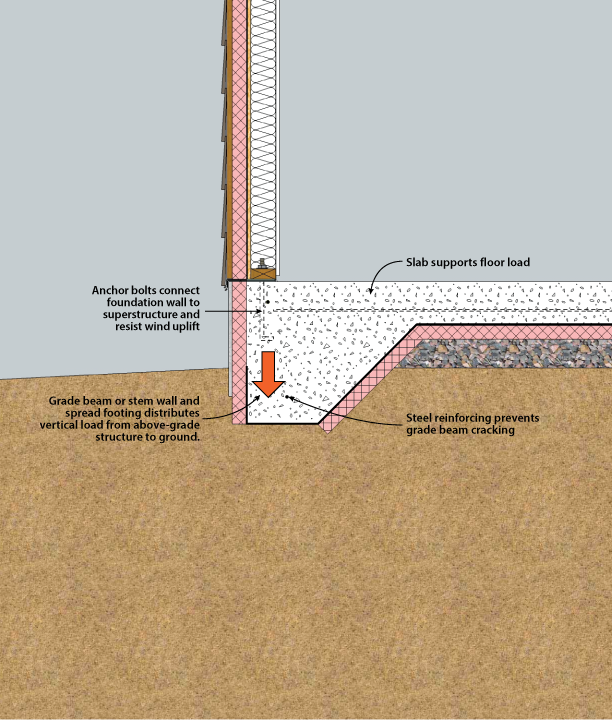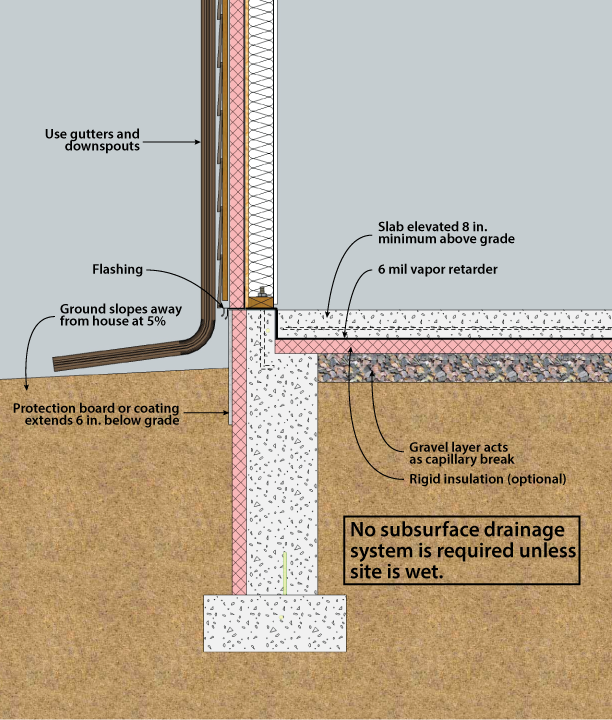WATER / MOISTURE MANAGEMENT
In general, moisture management schemes must control water in two states. First, since the soil in contact with the foundation and floor slab is always at 100% relative humidity, foundations must deal with water vapor that will tend to migrate toward the interior under most conditions. Second, liquid water must be kept from accumulating around and under the foundation. Liquid water comes from sources such as:
- Uncontrolled flows of surface water
- High water table
- Capillary flow through subsurface foundation assemblies

Figure 4-2. Structural System Components of Slab-on-Grade Foundation with Grade Beam

Figure 4-3. Drainage Techniques for Slab-on-Grade Foundations
Techniques for controlling the build-up and movement of moisture in the foundation are an essential component of the overall construction. Improper moisture management can lead to structural damage, damage to floor finishes, and mold growth, which can be very costly to repair and hazardous to one's health.
The following construction practices will prevent excess water in the form of liquid water and vapor from creating problems. This is done by using adequate drainage and by the use of vapor retarders. These guidelines and recommendations apply to thickened edge/monolithic slabs and stem wall foundations with independent above grade slab configurations (PATH 2006). These two slab-on-grade configurations are illustrated in Figures 4-2 and 4-3.
- Manage exterior ground and rain water by using gutters and downspouts and by grading the ground around the perimeter at least six inches of fall over ten feet of run.
- A vapor retarder such as a 6 mil thick polyethylene sheet should be placed directly below the concrete slab (DOE 2009). The vapor retarder will prevent moisture in the ground from diffusing through the slab and into the building. It is recommended that the vapor retarder be in direct contact with the concrete slab and that no sand or gravel be placed in between (Lstiburek 2008).
- A capillary break layer consisting of three to four inches of clean gravel (no fines) should be installed below the vapor retarder. This layer helps to further prevent bulk soil moisture from wicking up to the slab and allows for that moisture to be drained out if a drainage system is installed (PATH 2006). This layer also serves as a pressure field extender for a soil gas ventilation system, if one is installed
- Add a capillary break (a closed cell foam sill sealer or gasket) between the top of the concrete and the sill plate to prevent moisture migration between the concrete foundation and the wall structure above. For integral grade beam designs, extend the sub-slab vapor retarder under the footing, bringing it up to grade level.
- There are several different floor finishes that can be employed on a slab-on-grade foundation, however impermeable materials like vinyl flooring should be avoided because they prevent slab moisture from drying to the interior of the home. Moisture resistant finishes such as tile, terrazzo, and concrete stains are recommended specially for humid climates. Moisture sensitive finishes such as carpet and wood flooring may also be used. For these to be used appropriately, however, sub-slab, slab surface, or slab perimeter insulation should be used to moderate the slab temperature. Low temperatures can cause condensation on the slab, leading to damage to the finish as well as mold growth.
- Once the concrete for the slab has been poured, it will still contain large amounts of moisture and has to be allowed to cure. It is recommend that low water content concrete be used to reduce the amount of left over moisture that needs to dry after the slab is set. To prevent cracking and warping during the curing process, damp-curing techniques should be used in conjunction with welded wire fabric reinforcement. Horizontal, continuous, #5 rebar reinforcement at the top and bottom of stem wall or thickened slab edge should also be used to prevent cracking (PATH 2006). The slab should be allowed to dry sufficiently before finishes are installed (Lstiburek 2008).
For more information visit Water Managed Foundations within the Building America Solution Center.

